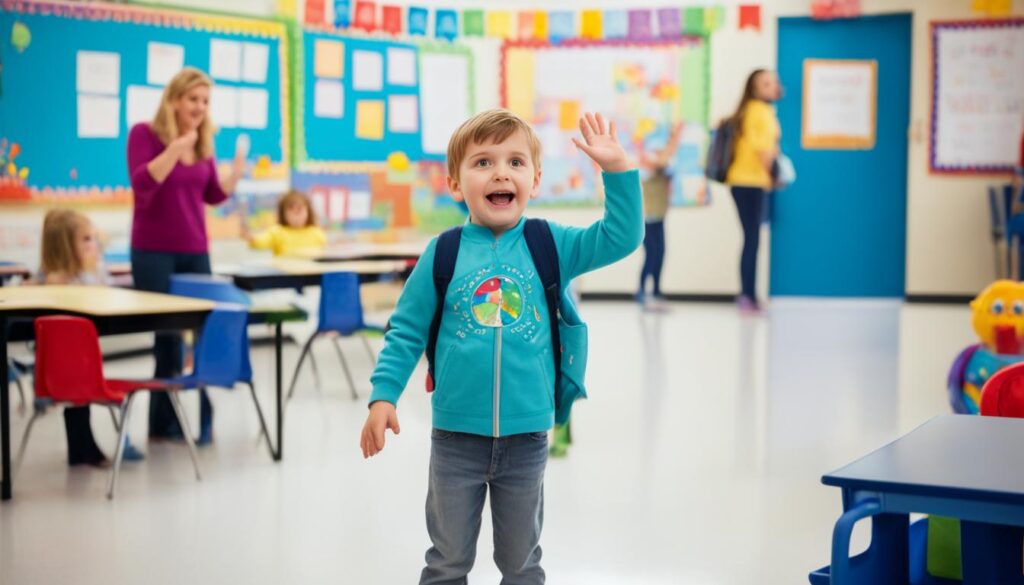Do you remember feeling separation anxiety for the first time? That tight feeling in your chest, the worry, and the fear of being alone? Now, imagine that feeling every time you entered a classroom. For young kids, especially preschoolers, this fear can make starting school really tough.
But, there’s good news! Teachers and parents have effective ways to help. They can ease this anxiety and make learning a positive time. By doing things like introducing themselves early and validating the child’s feelings, the classroom becomes a happier place for everyone.
So, what can you do to help with separation anxiety in the classroom? We will look at useful tips and ideas that can make school a better experience for kids.
Key Takeaways:
- Separation anxiety is a normal part of growing up.
- Getting to know teachers beforehand can help kids feel more at ease.
- Being a main support and recognizing how a child feels can create trust and comfort.
- Having a soothing morning routine, normalizing anxiety feelings, and giving choices in activities can aid in managing separation anxiety at school.
- Teachers are key in dealing with separation anxiety. They make a supportive space with fun activities, a clear plan for the day, and specific spots for each student.
Understanding Separation Anxiety in Young Children
Separation anxiety is part of childhood growth. It happens when kids are apart from those they love most. This usually starts around 7 to 8 months old. It can come back when they begin preschool or kindergarten.
Kids may cry, have tantrums, or hold tight to their caregivers when they feel this way. These are normal ways they show how they feel. We shouldn’t worry about it too much.
It’s key for parents and caregivers to know that this is common. It shows kids have a deep bond with them. They are also getting used to new places and ways of doing things.
Supporting and reassuring kids during this time is very important. Being consistent, keeping things familiar, and talking openly can make them feel safe.
Teachers in preschool and kindergarten are also crucial in dealing with this. They can make classes warm and inviting. This helps lower kids’ worries and ease them into school life.
- Be warm and welcoming: Greet each child individually, fostering a sense of belonging and familiarity.
- Establish a routine: A predictable schedule can provide a sense of security and help children feel more at ease.
- Encourage peer relationships: Facilitate opportunities for children to form friendships with their classmates, promoting a supportive social environment.
- Provide comfort objects: Allowing children to bring a special toy or blanket from home can provide them with a sense of comfort during periods of separation.
- Engage in storytelling: Reading books that address separation anxiety can help children identify and process their feelings.
Knowing separation anxiety is normal helps a lot. Parents, caregivers, and teachers can use certain ways to support kids. This helps them handle their feelings better. It allows them to do well in their early school years.
Strategies for Dealing with Separation Anxiety in Preschoolers
Handling separation anxiety in preschoolers is tough for parents and teachers. But, there are ways to make it easier and help children adjust. These strategies create a nurturing space where kids feel secure and at ease.
Introduction and Familiarization
Getting to know students before school starts is key. It helps preschoolers get comfortable with their new teacher. It builds trust and shows them they are in good hands.
A friendly greeting every morning can lessen their worry. It makes them feel safe and like they belong. Showing you understand and care makes a big difference.
Establishing a Sense of Routine and Security
A consistent morning routine makes preschoolers feel safe. A set start to their day, with activities like circle time, brings comfort. It makes the classroom feel more familiar.
Telling kids it’s okay to miss their parents is important. Letting them know their feelings are okay can reduce their stress. Encourage them to talk about how they feel.
Choice and Engagement
Letting kids choose what to do gives them control. This can make them feel less anxious because they can decide on parts of their day.
Keeping kids busy with fun learning can distract them from missing home. Things like creative projects or games hold their interest. It helps lessen their anxiety about being away from their parents.

| Strategies for Dealing with Separation Anxiety in Preschoolers | Benefits |
|---|---|
| Introduce yourself ahead of time | Familiarizes students with the teacher |
| Be the primary point of contact | Develops trust and a feeling of safety |
| Give the student a special role | Empowers preschoolers and enhances their sense of belonging |
| Acknowledge their feelings | Validates their emotions and provides reassurance |
| Provide a calm and quiet morning routine | Establishes structure and security |
| Normalizing separation anxiety | Helps preschoolers understand their emotions |
| Offer choices and different activities | Gives a sense of control and minimizes anxiety |
| Engage preschoolers in meaningful activities | Redirects focus and promotes active learning |
Dealing with Separation Anxiety in Older Children
Some older kids still feel separation anxiety after age 3. If this anxiety lasts a long time and is intense, it might be Separation Anxiety Disorder (SAD). Knowing the signs of SAD helps us support these kids better.
Signs of Separation Anxiety Disorder
Older children might show different signs of Separation Anxiety Disorder, for example:
- Excessive tiredness
- Fear of being away from home or family
- Refusal to go to school
- Frequent physical complaints, such as headaches or stomachaches
If a child shows these signs, talking to their parents or guardians is key. Teachers and parents can team up to help the child with their anxiety.
Sometimes, teachers need help from child mental health experts. School social workers or psychologists can offer expert advice and support.
Older children with separation anxiety need understanding, care, and teamwork. With the right support, these kids can overcome their anxiety. They will do well in school and in life.
| Signs of Separation Anxiety Disorder | Ways to Provide Support |
|---|---|
| Excessive tiredness | Ensure the child has adequate rest and create a calming environment |
| Fear of being away from home or family | Encourage gradual exposure to separation, starting with short periods of time |
| Refusal to go to school | Collaborate with school personnel to create a positive and supportive environment |
| Frequent physical complaints, such as headaches or stomachaches | Validate the child’s feelings and provide reassurance while seeking medical advice if necessary |
Tips for Parents Coping with Separation Anxiety
Separation anxiety is tough for both kids and parents. Seeing your child upset when you leave can make you anxious. But there are ways to deal with your feelings and help your child adjust.
- Start small: Take your child to see their school before the first day. This can make parting less daunting for you both.
- Stay connected: Remember, you can talk to your child’s teacher. Knowing you can get updates helps ease worries.
- Share updates: Schools often share photos or news about your child’s day. This keeps you in the loop and less worried.
- Connect with other parents: Meet other parents in the program. Sharing tips with others in the same boat can be comforting.
- Reassuring letter: Some schools send a letter with advice for parents. This letter is full of helpful tips on dealing with separation anxiety.
With these strategies, parents can manage their own anxiety and help their child handle new situations. Remember, it’s normal for kids to feel anxious about being apart. With time and support, you both will get through it.

Tips for Teachers on Managing Separation Anxiety in the Classroom
Teachers play a crucial role in easing separation anxiety for students. By using the right strategies, they can make the classroom a place where everyone feels safe and valued. Here are effective ways to help kids with separation anxiety:
- Create centers that are fun and relaxing: Having areas where learning is interactive can help students forget their worries. This encourages them to join in more.
- Plan your day well: A clear schedule gives students a sense of safety and predictability. Telling them about the day’s activities can make them feel more at ease.
- Set up a calm-down spot: A quiet area with soothing toys and books can help anxious students calm down. This space is for them to relax and feel better.
- Share stories about separation anxiety: Reading books on this topic lets students know their feelings are normal. It shows them they’re not alone in feeling this way.
- Give each child a personal space: Having a spot like a cubby or desk makes students feel they belong. This personal area can reduce their anxiety and make them feel safe.
- Get extra help: An assistant teacher can offer more support to anxious children. Working with colleagues experienced in anxiety can bring new ideas for helping students.
- Know when to seek more help: Some kids may need care from a professional. Spotting signs of severe anxiety and talking to parents is important. This can lead to further support from school counselors or psychologists.
Using these strategies, teachers can build a caring classroom that supports students with separation anxiety. Every step taken to help these students can greatly improve their happiness and success at school.
| Benefits of Teachers Managing Separation Anxiety | Tips for Teachers |
|---|---|
| 1. Improved academic performance | – Create engaging and low-stress centers |
| 2. Foster a positive classroom environment | – Develop a solid plan for the day |
| 3. Enhanced emotional well-being | – Introduce a calm-down corner |
| 4. Increased student engagement | – Read stories that address separation anxiety |
| 5. Strengthened teacher-student relationships | – Create designated spaces for each child |
Extra Strategies for Helping Children with Separation Anxiety
There are more ways to help kids deal with separation anxiety. Comfort items like family photos, stuffed toys, or special blankets are helpful. Kids find security in these familiar things. They feel less anxious with them around.
Puppets can be great for calming kids and helping them with their feelings. With puppets, kids can share what they’re feeling and what they need. This playtime helps them become stronger emotionally and learn how to handle their anxiety.
Visual aids like calendars and picture schedules are also useful. They show time in a way kids can understand, making things less stressful. With a clear plan for the day, kids know what to expect. This helps them feel more secure and at ease.
Showing extra care and attention is key for kids who are anxious about separating. Listen to them, validate their feelings, and reassure them. This support makes them feel understood. In a caring environment, kids can share their feelings and start to deal with their anxiety.

